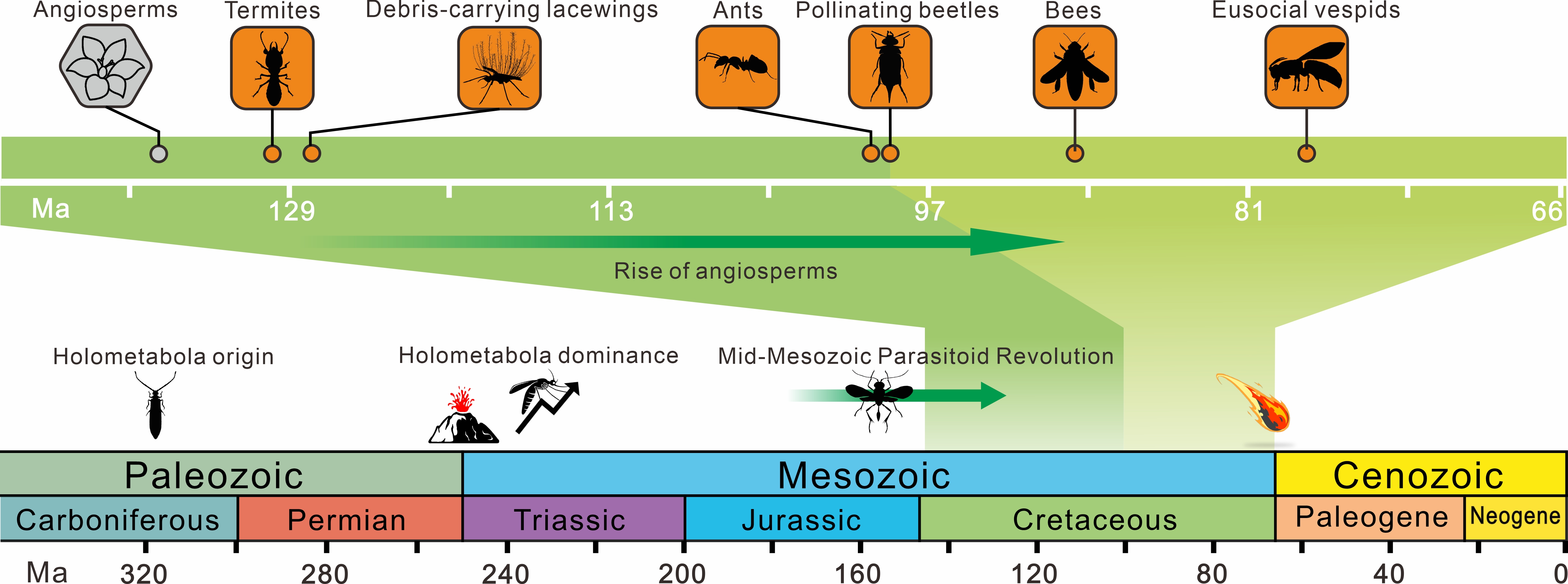Insects are today the most diverse group of organisms on Earth and are responsible for a wide array of ecosystem services. They are important components in modern terrestrial ecosystems, and commonly influence ecosystem cycling of carbon and nutrients by modulating the quality and quantity of resources. Understanding the evolution of insects and their roles in deep-time terrestrial ecosystems are key to decoding the rise of modern terrestrial ecosystems.
Recently, Prof. WANG Bo from the Nanjing Institute of Geology and Palaeontology, Chinese Academy of Sciences (NIGPAS), synthesized the fossil record of Mesozoic holometabolous insects and explored fossil evidence for the evolution of key ecological interactions in terrestrial environments.
This study was published in Trends in Ecology & Evolution on March 11, 2022.
The Mesozoic is a key era for the rise of the modern insect fauna. Among the most important evolutionary events in Mesozoic insects are the radiation of holometabolous insects, the origin of eusocial and parasitoid insects, diversification of pollinating insects, and development of advanced mimicry and camouflage. These events are closely associated with the diversification of insect ecological behaviors and colonization of new ecospaces. During the past two decades, there has been enormous progress in our understanding of these events due to the discovery of new fossils and lagerst?tten, which also provide robust evidence for insect-plant and insect-insect ecological interactions.
The fossil record of insects contains larger geographic, temporal and taxonomic gaps than the fossil record of vertebrates and of some marine invertebrates. In fact, more than half of all described insect occurrences in the fossil record come from major Lagerst?tten. Due to the depauperate and uneven fossil record, the estimates of insect paleodiversity is mainly restricted to higher-level taxa and the detailed ecological response of insects to several key environmental events is still unclear. Furthermore, there is a preservational bias toward medium-size insects for compression–impression fossil deposits. Although amber can preserve minute insects, before the widespread occurrence of amber with insect inclusions, the fossils mainly showed the patterns of diversity of medium-size insects. This reminds us that the currently-known evolutionary history of some insect interactions may be incomplete.
Recent work on the paleobiology, phylogenetics, taphonomy, and other related fields has facilitated novel understanding of important evolutionary events in Mesozoic entomology and opened up new perspectives. These events are closely associated with the diversification of insect ecological behaviors and colonization of new ecological niches entailing closer associations with various plants and animals. Mesozoic insects no doubt played a key ecological role in reconstructing and maintaining terrestrial ecosystems. Nonetheless, the potential ecological roles of these insects are not yet fully explored and their importance warrants more detailed paleoecological study.
Many extant terrestrial insects are undergoing dramatic declines in abundance and diversity largely due to anthropogenic deforestation and global warming. Although the phylogenetic landscape was distinctly different in the geological past from that of the present day, a greater understanding of the history of insects could make it possible to formulate broader ecological predictions and policies for the future.
"We need to understand particularly their pioneering ecological roles in deep-time terrestrial ecosystems and their response to extreme environmental events." Prof. WANG says, "in particular, paleobiological research provides empirical evidence of how insect communities were shaped by natural climatic events of the past, especially global warming in the Mesozoic."
Examining changes in taxonomic diversity, morphological disparity, and ecological shift of insects in concert can provide a more comprehensive view of the evolutionary trajectory and could illuminate underlying evolutionary processes without resort to ‘just-so’ stories. Such studies as discussed above may help to mitigate future changes in insect diversity and abundance faced with accelerating global environmental change.
This work was supported by the Strategic Priority Research Program of the Chinese Academy of Sciences, the Second Tibetan Plateau Scientific Expedition and Research, and the National Natural Science Foundation of China.
Reference: Wang Bo, Xu Chunpeng, Jarzembowski E.A. (2022) Ecological radiations of insects in the Mesozoic. Trends in Ecology & Evolution, https://doi.org/10.1016/j.tree.2022.02.007.

Figure 1. The origins of some key insects and plants according to fossil evidence.

Figure 2. Geological range of insect mimesis, debris-carrying camouflage, and eusocial behavior.
Contact:
LIU Yun, Propagandist
Email: yunliu@nigpas.ac.cn
Nanjing Institute of Geology and Palaeontology, Chinese Academy of Sciences
Nanjing, Jiangsu 210008, China
